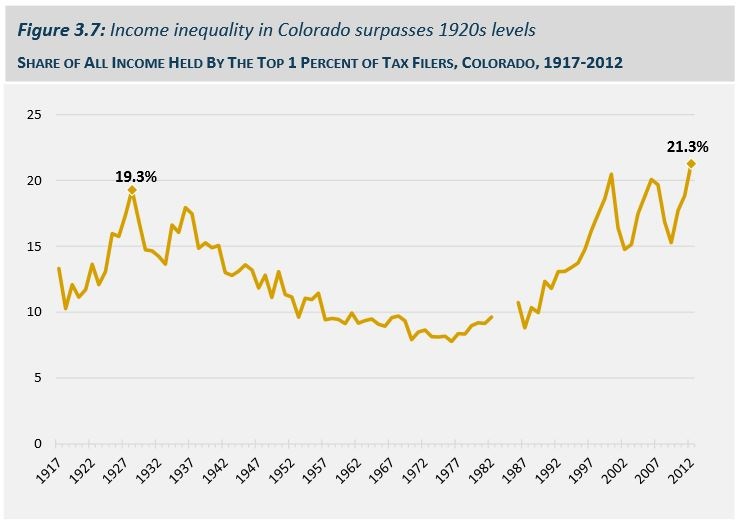Study: Income Inequality Widens in Colorado

One of several findings from the Colorado Center on Law & Policy report State of Working Colorado 2015-16.
By Kristin Jones
The richest Coloradans have gained disproportionately from the economic recovery, while lower- and middle-income families have yet to fully recuperate from the recession, according to a new report published by the Colorado Center on Law & Policy (CCLP), an organization that promotes economic justice.
CCLP is among a group of organizations that are funded by The Colorado Trust to advocate for health equity.
Median household income in the state is still $2,000 less than it was in 2007, the CCLP study found. But the period before the recession wasn’t great for Colorado workers, either. In fact, median income is nearly $3,000 less than it was 15 years ago.
But the overall trend doesn’t capture the disparities across geographies, race and ethnicity. Coloradans living in rural counties (especially in the San Luis Valley), single parents, minorities and the poor suffered disproportionately from the recession, and have been denied the gains of the recovery.
Among the report’s findings:
- Douglas County households were earning $102,000 on average in 2014, while Costilla County households made just $29,000.
- The household income for blacks in Colorado was, on average, only about 62 percent of income among whites in 2014, and the gap is widening. The median income of black families in Colorado is still 12 percent lower than it was in 2007. By comparison, the median income of white families is 3 percent less than in 2007.
- Latino households made about 65 cents for every dollar white families earned in 2014. But they are moving in the right direction. Hispanics are the only large ethnic group that has seen income growth since 2007—by about 4.6 percent.
- Asian households made about 90 cents for every dollar made by white households. Median income among Asians is down 6.3 percent from 2007.
- For the most part, the worse off you were in 2007, the less likely you are to have recovered from the recession. Income in the lowest quintile is 3.4 percent less than it was 2007, while for the highest quintile, income has recovered to its 2007 level.
- In Colorado, women earn less than men with the same level of education. The gap is widest at the highest levels of education; women with a bachelor’s or graduate degree earn just 71 cents for every dollar earned by men with the same credentials.
- Wealthy Coloradans are doing just fine, thanks. The top 1 percent in Colorado took in an unprecedented 21 percent of the income in 2012—higher than they did even in the gilded era of the 1920s.
- The top 1 percent of earners in Colorado saw their income grow an astounding 48 percent between 2009 and 2012. In fact, all of the income growth in this period went to the wealthiest bracket—while the other 99 percent got none of it.
The entire report is available on the CCLP website.